Kathleen Flinn's Blog, page 27
May 18, 2012
Friday Reads: Drink Gin, Eat Vegetables
Anyone around me regularly knows I’m a voracious reader. Mike can’t seem to put in enough bookshelves. I’ve been posting what I’ve been reading via #Fridayreads on Twitter, but I’ve decided to list them here on the blog each week, too. What follows aren’t really reviews per se, but a book listed here is generally a recommendation.
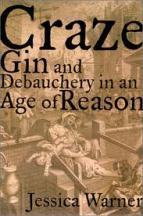 I’m researching a new book that takes place in 18th Century London and focuses (in part) on the curious world of gin. So, in the past week, I’ve checked out all the books on gin from the Seattle Library System. (The look on the librarian’s face was worth the hassle of carting 22 books home.) I’m working my way through the stack, but so far my favorite book is Craze: Gin and Debauchery in an Age of Reason. Author Jessica Warner offers thorough research combined with concise writing on the madness that took over the capitol in the early 1700s. It had so much good information that rather than mark up the library copy, I had to buy my own.
I’m researching a new book that takes place in 18th Century London and focuses (in part) on the curious world of gin. So, in the past week, I’ve checked out all the books on gin from the Seattle Library System. (The look on the librarian’s face was worth the hassle of carting 22 books home.) I’m working my way through the stack, but so far my favorite book is Craze: Gin and Debauchery in an Age of Reason. Author Jessica Warner offers thorough research combined with concise writing on the madness that took over the capitol in the early 1700s. It had so much good information that rather than mark up the library copy, I had to buy my own.
I had to track down a copy of London Eats Out: 500 Years of Capitol Dining published by the Museum of London, but it was so worth it. Organized by century, with break outs on early food writing, the dominance of beef steak dining clubs and loads of illustrations, it’s a thin volume that packs in a load of information. It kind of reminded me of one of those old Time-Life series books.
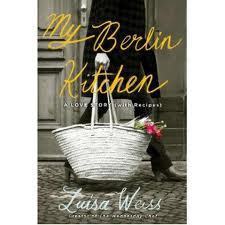 I also finished the galley of My Berlin Kitchen, the upcoming book by Luisa Weiss, creator of The Wednesday Chef. It’s terrific. I’ve been impressed by the clarity of her writing, her honesty, the story pacing and the gushy, wonderful love story. It comes out in September. Go pre-order it now.
I also finished the galley of My Berlin Kitchen, the upcoming book by Luisa Weiss, creator of The Wednesday Chef. It’s terrific. I’ve been impressed by the clarity of her writing, her honesty, the story pacing and the gushy, wonderful love story. It comes out in September. Go pre-order it now.
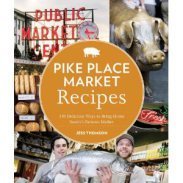 I attended the launch party for Pike Place Market Recipes by Jess Thompson on Tuesday, so I’ve only had a chance to look through it but it’s a lovely book featuring purveyors and restaurants in and around Seattle’s iconic market along with 130 recipes. Talking to her the next day, I learned it will be one of four books she’ll have coming out in a two-year time period. I feel like such a slacker.
I attended the launch party for Pike Place Market Recipes by Jess Thompson on Tuesday, so I’ve only had a chance to look through it but it’s a lovely book featuring purveyors and restaurants in and around Seattle’s iconic market along with 130 recipes. Talking to her the next day, I learned it will be one of four books she’ll have coming out in a two-year time period. I feel like such a slacker.
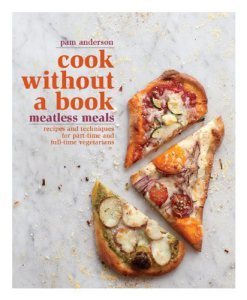 Every week, I rotate a couple of cookbooks onto my kitchen counter. This week (well, the past two weeks), one of them has been Cook Without a Book: Meatless Meals by the incomparable Pam Anderson. She writes recipes in such a useful way that I’m always recommending her books to people. This one features a clear “master recipe” and then countless variations on the main theme. I’ve used her book so much in the past couple of weeks that it’s actually changed our usual eating routine. I’m now making grain-based salads, versions of her grab-and-go breakfast tortillas and variations on Asian stir fry. If you’re trying to cut down on your meat consumption, give it a look. Pam has a knack for coming up with cooking strategies for busy people.
Every week, I rotate a couple of cookbooks onto my kitchen counter. This week (well, the past two weeks), one of them has been Cook Without a Book: Meatless Meals by the incomparable Pam Anderson. She writes recipes in such a useful way that I’m always recommending her books to people. This one features a clear “master recipe” and then countless variations on the main theme. I’ve used her book so much in the past couple of weeks that it’s actually changed our usual eating routine. I’m now making grain-based salads, versions of her grab-and-go breakfast tortillas and variations on Asian stir fry. If you’re trying to cut down on your meat consumption, give it a look. Pam has a knack for coming up with cooking strategies for busy people.
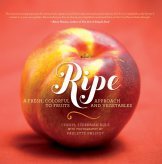 Finally, I’ve been entranced by Ripe: A Fresh, Colorful Approach to Fruit and Vegetables by Cheryl Sternman Rule with photography by Paulette Philipot. It provides a dose of gorgeous food porn plus pragmatic and useful ideas on how to use even the most obscure vegetables.
Finally, I’ve been entranced by Ripe: A Fresh, Colorful Approach to Fruit and Vegetables by Cheryl Sternman Rule with photography by Paulette Philipot. It provides a dose of gorgeous food porn plus pragmatic and useful ideas on how to use even the most obscure vegetables.
The latter has been useful in developing the class that I’ll be teaching at The Book Larder in Seattle next Tuesday. I think there are a couple slots left in you’re interested.








May 7, 2012
The 2020 Food Consumer in Eight Trends
Oh sure, lots of people and groups toss about “food trend” statements. But one group has tapped into scientific method to get a longer-term look at what people will want from their food a decade from now. Are they right? Who knows. Like any trends predictor, only time will tell. But what’s interesting about this particular set of descriptions is how much it echoes what others are stating, but of course, with a stuffier, more academic tone. The report says:
Health will be a determining factor in the future of food. People are increasingly concerned about maintaining their health and that is why they are demanding wholesome products adapted to their own personal needs.
Compare that to this line from a story on the same theme by Gary Hirshberg in the populist site The Huffington Post.
Americans care about the food we eat and feed our families, now more than ever. In the span of just a few weeks, “pink slime” became a consumer phenomenon, leading to the unprecedented rapid-fire removal of the product from major stores and schools, the closure of production plants and USDA approval of voluntary labeling. Talk about legislation through retail.
The group identified eight key trends, and assigned each an identifying moniker. The top one was “Food Telling” or “Food with a Message,” described as “a demand for transparent, attractive, accessible information.” I see that as being triggered by the likes of “pink slime.” I overheard people talking about it on plane to New York last week and the woman discussing it were not food people – they were both mothers of young kids and they were angry. Furious. Explosively so, and willing to vote out pink slime with their wallets.
Some of the other trends seemed extensions of existing ones, such as “Eater_tainment,” or food that’s doubles as entertainment or “EgoFood,” namely food that extends the personality of the individual. You can read the full story at Science Codex. Curious to see what others think of it.








May 1, 2012
Cook with me on May 22 in Seattle

Fear not the artichoke
Just a heads up that I will be teaching a class on how to cook all the various (and sometimes confusing) vegetables and fruits that show up in a Community Supported Agriculture (CSA) or show up at stands at farmer’s markets. Along with this, I’ll be talking about how we can all waste a lot less fresh produce. I’ll be doing this at the fabulous independent culinary bookstore The Book Larder here in Seattle.
Most of you know that I don’t teach a lot of classes these days due to book deadlines. (So far in 2012, I’ve taught just two.) So if you want to come cook with me, sign up! Although just announced, the 24 slots are filling up quickly.
In the meantime, tell me this: what fruit or vegetables confuse you the most? You know, the ones where you look at them and think, ”I really don’t know what to do with that…”








Cook with me on Earth Day in Seattle

Fear not the artichoke
On May 22nd, Earth Day, here’s what I’ll be doing: teaching a class on how to cook all the various (and sometimes confusing) vegetables and fruits that show up in a Community Supported Agriculture (CSA) or show up at stands at farmer’s markets. Along with this, I’ll be talking about how we can all waste a lot less fresh produce. I’ll be doing this at the fabulous independent culinary bookstore The Book Larder here in Seattle.
Most of you know that I don’t teach a lot of classes these days due to book deadlines. (So far in 2012, I’ve taught just two.) So if you want to come cook with me, sign up! Although just announced, the 24 slots are filling up quickly.
In the meantime, tell me this: what fruit or vegetables confuse you the most? You know, the ones where you look at them and think, ”I really don’t know what to do with that…”








April 18, 2012
Coming up: LA Times Book Fest, ASJA Awards, Children’s Trust in Seattle
Today, (Saturday, April 21), I am on a panel at the Los Angeles Times Festival of Books moderated by Times food editor Russ Parsons. I’m pretty psyched about it. The theme is “The Food Chain,” with the general plan to discuss the issues affecting cooking and eating in America. Also on the panel will be Julie Guthman, author of Weighing In: Obesity, Food, Justice, and the Limits of Capitalism, a subject that I personally think is the most intriguing beat in journalism these days, and Tracie McMillan, who penned The American Way of Eating: Undercover at Walmart, Applebee’s, Farm Fields and the Dinner Table. You may have heard of this one in the news; she is the latest young, single female to be unjustly attacked by Rush Limbaugh for what he says is just another “overeducated,” single, elitist female taking aim at Walmart shoppers and telling lower classes what to eat. If Limbaugh had read the book, he would know that wasn’t what the whole thing was about at all. The panel will be at 3 p.m. I’ll link to any audio should it be available.
Next week, I head back to New York for something very exciting. I will be attending the awards ceremony for the American Society of Journalists and Authors (ASJA). The judges selected my latest book, The Kitchen Counter Cooking School as the winner in the non-fiction memoir/autobiography category. I feel very honored as ASJA is such a remarkable institution. Once I have a photo, I will be sure to post.
I return quickly to Seattle Saturday, April 28, in time to participate in The Children’s Trust Charity Event fundraiser To Prevent Child Abuse & Neglect. I’ll be teaching a cooking course with several other generous people from Seattle’s food loving community. If you are in Seattle, here are the details.
Master Your Cooking Skills
To Prevent Child Abuse & Neglect
Saturday, April 28, 6:30-10pm
Blue Ribbon Culinary Center, Seattle








March 19, 2012
Who really “writes” celebrity cookbooks? On the NY Times “ghost writer” kerfuffle
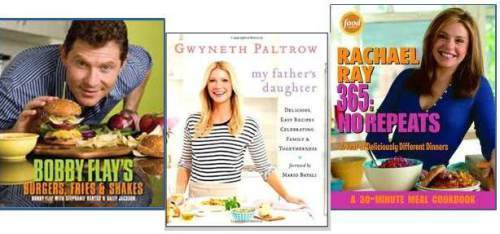 A story “I Was a Cookbook Ghostwriter” in The New York Times last week went in detail about how some celebrity chefs rely on ghostwriters to help them get their books in shape for publication. The story mostly recalled the author, Julia Moskins, personal experiences in the trenches of cookbook ghost writing. (Surprisingly, Moskin doesn’t mention that Martha Stewart’s early book, Entertaining and Weddings were both ghost written by writer Elizabeth Hawes.)
A story “I Was a Cookbook Ghostwriter” in The New York Times last week went in detail about how some celebrity chefs rely on ghostwriters to help them get their books in shape for publication. The story mostly recalled the author, Julia Moskins, personal experiences in the trenches of cookbook ghost writing. (Surprisingly, Moskin doesn’t mention that Martha Stewart’s early book, Entertaining and Weddings were both ghost written by writer Elizabeth Hawes.)
Among the story’s specifics was that a writer, Julia Turshen, worked with Gwyneth Paltrow on her book, My Father’s Daughter. It also lays claim that ">Rachel Ray and Jamie Oliver also employs the use of ghostwriters to develop at least some recipes. Both authors took aim at the paper’s assertion via Twitter, denying the allegations:
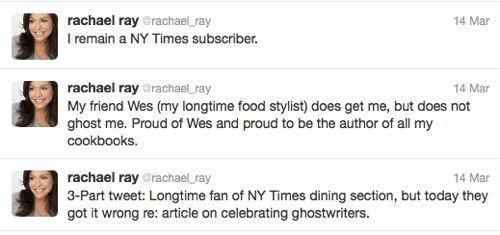
 Jamie Oliver went about it the old-fashioned way; he had a staffer contact Moskin’s editor directly, a point illuminated when she released a follow-up to the story early today. Apparently, the chefs were insulted by the word “ghost writer,” but I’m wondering if the issue here, especially in Gwyneth’s case, is more a semantic discussion.
Jamie Oliver went about it the old-fashioned way; he had a staffer contact Moskin’s editor directly, a point illuminated when she released a follow-up to the story early today. Apparently, the chefs were insulted by the word “ghost writer,” but I’m wondering if the issue here, especially in Gwyneth’s case, is more a semantic discussion.
When most readers see the recipe in a cookbook, they see a simple head note, some ingredients and instructions. Writing those few hundreds words isn’t the time-consuming part. The real work of cookbooks is more complicated: finding the concept, developing a balanced framework for the content, expanding it into a cookbook proposal, then doing research into ingredients before testing, reworking and retesting the actual recipes — and that’s before you get into food photography. In the UK television series, “Fifteen,” I recall Jamie Oliver telling a student that he wrote his books by speaking into recorder; presumably someone else transcribed them, extracted what he was after and helped him hone and shape the final verbage.
In writing about the book as it was coming out, Turshen penned her own account of the collaboration on the book for Food & Wine. “Producing the book required long days of brainstorming, grocery shopping, cooking, testing, readjusting, accumulating tall stacks of dirty dishes and writing everything down,” Turshen wrote, adding it took a “year or so gathering [Gwyneth's] recipes, and the stories behind them.”
Meanwhile, in her author’s note, Gwyneth writes Turshen ”quantified, tested, and retested every recipe, oversaw the production of the photos, helped brainstorm in a crisis, and above all was my intellectual and emotional support through the whole process.”
Collaboration? Sure. Ghost writing? Or, as Moskin referred to it in her follow-up story, “Ghost cooking?” That’s how you define it.
Generally, the phrase “ghost writing” describes someone who writes on behalf of other people who tend to take the credit. Or, sometimes they collaborate and they get an “as told to” or “with” kind of credit. Executives, politicians and celebrities of screen and sport do it all the time. Sometimes the writer interviews the subject and writes every word, sometimes they take a mass of written notes and partly-conceived chapters and whip it into shape. Or, they may help with organization, read over the author’s work, haunting them to keep the project on track.
And so, a confession. In the 1990s, I was hired to ghostwrite a book for a U.S. congressman. A guy called me at my newspaper, praised my work and we negotiated a deal. He handed me a spiral notebook with a couple hundred pages of writing and notes from various sources, including the congressman. I met the congressman only once. My job was to organize it into a coherent format and write it into one voice. (For a variety of reasons, mainly political climate change, the book wasn’t published.) Also, I once conducted research and wrote chapters in a book for a travel writer. That’s typical ghostwriting. You write, they take credit, you keep your mouth shut and cash your check.
The reason is that a cookbook is more complicated due to its many working pieces. The story rightly notes that doing grunt work for better-known personalities is a fairly common job for food writers. Many chefs don’t develop recipes or cook in a way that translates well enough for home cooks to follow.
Working on one of my first food stories, a well-known chef assured me that he had a recipe written down so I didn’t need to take notes as he cooked. Thankfully, I did anyway. When he finally got me the recipe a week later, it was written in Portugese and designed to feed 50. So, I had to figure out the language, scale it down, track down substitutions for commercial ingredients and make the dish no less than eight times, tweaking and fixing it. But you know what? That recipe gave him the credit. After all, it was his dish. I was merely the conduit – admittedly with a byline. Later, when the restaurant contributed “his” recipe to a compilation cookbook, neither me or my newspaper got a mention. That happens far more often than you think.
So I think that Gwyneth is right when she says she “wrote every word;” and I think the Times’ writer Julia Moskins is right when they say she had “a collaborator” who did a lot of heavy lifting on her project. (A caption calling Turshen a “ghostwriter” for Paltrow seems a bit strong; as a writer, Moskin likely didn’t even see that until the paper came out.)
At the end of all this, I’m less interested (or surprised) that Bobby Flay has someone develop a spice rub section (he admits that he does), and more curious about the many delicious “blind items” in the story, as noted by Eater, including one note about a “famed chef” who wrote a tome on regional cooking that was actually developed by a New York-based food writer and another left under house arrest in Columbia when the chef wandered off…








Who Really Writes Celebrity Cookbooks?
 A story "I Was a Cookbook Ghostwriter" in The New York Times last went in detail about how some celebrity chefs rely on ghostwriters to help them get their books in shape for publication. The story mostly recalls the author, Julia Moskins, personal experiences in the trenches of cookbook ghost writing. Surprisingly, Moskin doesn't mention that Martha Stewart's early book, Entertaining and Weddings were both ghost written by writer Elizabeth Hawes. Among the story's specifics was that a writer, Julia Turshen, worked with Gwyneth Paltrow on her book, My Father's Daughter. It also lays claim that ">Rachel Ray also employs the use of ghostwriters to develop recipes and prose. Both authors took aim at the paper's assertion via Twitter, denying the allegations:
A story "I Was a Cookbook Ghostwriter" in The New York Times last went in detail about how some celebrity chefs rely on ghostwriters to help them get their books in shape for publication. The story mostly recalls the author, Julia Moskins, personal experiences in the trenches of cookbook ghost writing. Surprisingly, Moskin doesn't mention that Martha Stewart's early book, Entertaining and Weddings were both ghost written by writer Elizabeth Hawes. Among the story's specifics was that a writer, Julia Turshen, worked with Gwyneth Paltrow on her book, My Father's Daughter. It also lays claim that ">Rachel Ray also employs the use of ghostwriters to develop recipes and prose. Both authors took aim at the paper's assertion via Twitter, denying the allegations:

 But I'm wondering if the issue here, especially in Gwyneth's case, is more a semantic discussion. When most readers see the recipe in a cookbook, they see a simple head note, some ingredients and instructions. Writing those few hundreds words isn't the time-consuming part. The real work of cookbooks is more complicated: finding the concept, developing a balanced framework for the content, expanding it into a cookbook proposal, then doing research into ingredients before testing, reworking and retesting the actual recipes — and that's before you get into food photography. In writing about the book as it was coming out, Turshen penned her own account of the collaboration on the book for Food & Wine. "Producing the book required long days of brainstorming, grocery shopping, cooking, testing, readjusting, accumulating tall stacks of dirty dishes and writing everything down," Turshen wrote, adding it took a "year or so gathering [Gwyneth's] recipes, and the stories behind them."
But I'm wondering if the issue here, especially in Gwyneth's case, is more a semantic discussion. When most readers see the recipe in a cookbook, they see a simple head note, some ingredients and instructions. Writing those few hundreds words isn't the time-consuming part. The real work of cookbooks is more complicated: finding the concept, developing a balanced framework for the content, expanding it into a cookbook proposal, then doing research into ingredients before testing, reworking and retesting the actual recipes — and that's before you get into food photography. In writing about the book as it was coming out, Turshen penned her own account of the collaboration on the book for Food & Wine. "Producing the book required long days of brainstorming, grocery shopping, cooking, testing, readjusting, accumulating tall stacks of dirty dishes and writing everything down," Turshen wrote, adding it took a "year or so gathering [Gwyneth's] recipes, and the stories behind them."
Meanwhile, in her author's note, Gwyneth writes Turshen "quantified, tested, and retested every recipe, oversaw the production of the photos, helped brainstorm in a crisis, and above all was my intellectual and emotional support through the whole process."
Collaboration? Sure. Ghost writing? That's how you define it.
Generally, the phrase "ghost writing" describes someone who writes on behalf of other people who tend to take the credit. Or, sometimes they collaborate and they get an "as told to" or "with" kind of credit. Executives, politicians and celebrities of screen and sport do it all the time. Sometimes the writer interviews the subject and writes every word, sometimes they take a mass of written notes and half-conceived chapters and whip it into shape. Or, they may help with organization, read over the author's work and keep the project on track.
In the 1990s, I was hired to ghostwrite a book for a congressman by one of his supporters. He called me at my newspaper, praised my work and we negotiated a deal. He handed me a spiral notebook with a couple hundred pages of concepts and notes from various sources, some more clearly articulated than others. My job was to organize it into a coherent format and write it into one voice. To earn some cash while trying to sell my first book, I conducted research and wrote chapters in a book for a writer who was otherwise going to blow his deadline. That's typical ghostwriting. You write, they take credit, you keep your mouth shut and cash your check.
But a cookbook is more complicated due to its many working pieces. The story rightly notes that doing grunt work for better-known personalities is a fairly common job for food writers. Many chefs don't develop recipes or cook in a way that translates for home cooks. Working on one of my first food stories, a well-known chef assured me that he had a recipe written down so I didn't need to take notes as he cooked. Thankfully, I did anyway because when he finally got me the recipe a week later, it was written in Portugese and designed to feed 50. So, I had to figure out the language, scale it down, track down substitutions for commercial ingredients and make the dish no less than eight times, tweaking and fixing it. But you know what? That recipe gave him the credit. After all, it was his dish. I was merely the conduit – admittedly with a byline. Later, when the restaurant contributed "his" recipe to a compilation cookbook, neither me or my newspaper got a mention. That happens far more often than you think.
So I think that Gwyneth is right when she says she "wrote every word;" and I think the Times' writer Julia Moskins is right when they say she had "a collaborator" who did a lot of heavy lifting on her project. (A caption calling Turshen a "ghostwriter" for Paltrow seems a bit strong; as a writer, Moskin likely didn't even see that until the paper came out.)
At the end of all this, I'm less interested (or surprised) that Bobby Flay has someone develop a spice rub section (he admits that he does), and more curious about the many delicious "blind items" in the story, as noted by Eater, including one note about a "famed chef" who wrote a tome on regional cooking that was actually developed by a New York-based food writer and another left under house arrest in Columbia when the chef wandered off…








March 15, 2012
Afternoon strawberries and champagne
 So my friend Allison and I were wandering around our neighborhood along the market street Rue Moufftard. Allison married our friend Michael last summer after a whirlwind romance, although the pair have known each other for 18 years. Her new husband was immediately reassigned to Paris, so last August, she found herself in a city she'd never visited in her life, unable to speak French and utterly baffled by the culture.
So my friend Allison and I were wandering around our neighborhood along the market street Rue Moufftard. Allison married our friend Michael last summer after a whirlwind romance, although the pair have known each other for 18 years. Her new husband was immediately reassigned to Paris, so last August, she found herself in a city she'd never visited in her life, unable to speak French and utterly baffled by the culture.
Months later, she's making strides with her French. Her husband travels all the time for business, so she's alone a lot but she makes the best of it she can, given that she's a newlywed and all. On Wednesday, she found out that she had been accepted to the Le Cordon Bleu to study patisserie. That same afternoon, I found out that my recent book had won first place in the memoir/autobiography category from the American Society of Journalists & Authors. To celebrate, we went for a long lunch and then happened by a stall selling the first of the season strawberries. "You know what we need?" I asked. "Champagne." We happened on a great wine shop where a woman recommended a bottle of bubbles. At precisely 3:44, we opened the champagne and started on the strawberries. The soft, gentle bubbles of the champagne offset the tartness of the strawberries. They were a lovely color if a bit tough, but it's March, what do you expect?
We sat in our apartment and looked out over the French rooftops, chatting about her upcoming education and missing our husbands. (My own Mike has been in London for three days.) Her husband comes home on Sunday. "To our husbands," she proposed.
"… and to their wives," I said. We clinked glasses. Sometimes, you need champagne to remind you of the things you need to celebrate, such as remembering how much you love your husband or cementing a new friendship.








March 14, 2012
Cooking in Paris with Monica Bhide
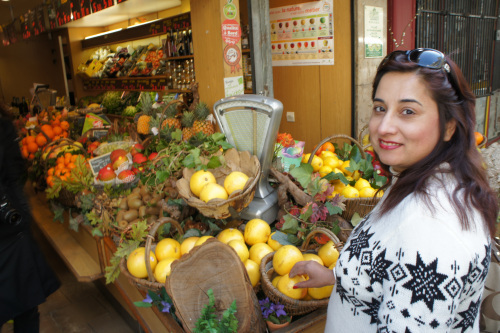
Monica Bhide at a Paris market
My dear writer friend Monica Bhide came to Paris a couple of days ago as part of a press trip for food writers. I had already planned to be in Paris for other reasons, including the Paris Cookbook Fair. I joined her for a day of her whirlwind excursion at Cook'n with Class, a lovely recreational cooking school in Montmartre.
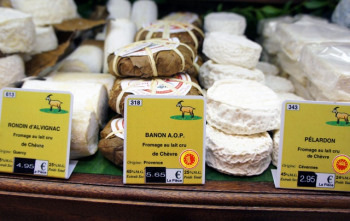
Goats cheese at a Quarterhomme, a Paris cheese shop.
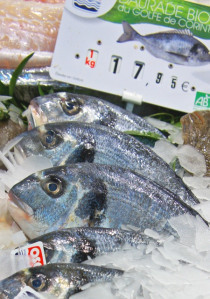
Dorade at the fish market
As part of their morning market tour class, we started the day with a tour of the local specialty food shops led by Chef Constance. Really, any day that starts in a Parisian cheese shop is destined to be pretty great. We inhaled the stinky goodness as she talked the group through the varieties of cow, goat and sheep's milk cheeses and explained how the AOC system in France works. Next, we stopped at a butcher where we lost half the group. One of the food writers had a deep-seated fear of birds and thus rendered poultry as a non-option. Another was a vegetarian who couldn't take the sight of plastic-wrapped meat in a supermarket much less the brutality of an authentic Parisian boucherie with items such as rabbits and chickens with the head and feet intact proudly displayed in a front cooler pushed out on the sidewalk. The pair rejoined us sometime after we hit a fish market to purchase a whole salmon from Norway and some fresh squid, something that neither Monica or I had ever prepped. In my case, it's from being raised in Florida, where squid is usually sold frozen — as fish bait.
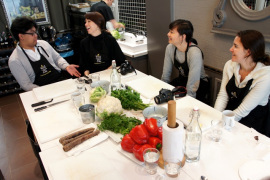
At Cook'n with Class in Paris
With our purchases intact, we went back to the school, a lovely bright space on a side street in Montmartre opened a couple of years ago by Chef Eric Fraudeau. The school's primary focus is to teach authentic French techniques to foreigners via genial half-day and evening classes. Interesting side note: While Americans remain their strongest clientele, Chef Eric reports that enough Chinese now request classes that he hired Chinese-speaking chefs to accommodate the demand, now about 15% of their business.
The school is a welcoming, efficient operation, and I was impressed by Chef Constance. She kept up a good pace with a patient, yet commanding authority as we prepared a cake batter, prepped red peppers, sliced onions, pulled bones from the salmon, cleaned the squid and sautéed chopped apples in butter.
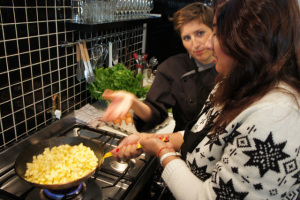
Chef Constance instructs Monica on saute technique
"For the market class, the menu is always different because you never really know what we end up buying," Constance explained. (She emailed full recipes for each dish the following day.) Our menu included: a foamy soup made from purple carrots and a creamy cauliflower velouté; poached eggs atop a bed of sautéed red peppers and onions garnished with fried walnut bread; pan-seared salmon and spiced sautéed calamari with roasted cauliflower; a selection of cheeses; and sponge cake topped with apples in a caramel cream sauce for dessert. All of it was terrific.
Among other things, Chef Constance taught us a great trick: poaching eggs in heat-resistant plastic. She pulled a sheet of plastic over a small bowl, cracked the egg into it, squeezed out the air and then secured it with a knot. The eggs were then placed in hot water for a few minutes until cooked. The result: a perfect poached egg.
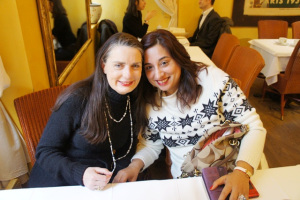
Jonell and Monica
After lunch, Monica and I met up with Geneva-based writer Jonell Halloway, who runs the blog The Rambling Epicure, and hit the famous Mariage Freres teahouse on rue des Grands-Augustins on the Left Bank. For two hours, we chatted about cooking, Paris and food writing as the white-gloved attendants kept refilling our cups. Such a lovely day, and I'm thankful to have spent it with Monica, one of my favorite people.








Recipe: Chorizo Basquaise Poached Egg with Olive Oil Crouton
Recipe adapted with permission from the Cook'n with Class school in Paris and my teacher, Chef Constance Deledalle. By the way, Constance has a fun blog which she pens in English about her culinary adventures in Paris and beyond. For the bread, she used a hearty walnut-studded wheat, but you could likely use any day-old bread with good results. Serves six.
6 eggs
8 bell peppers, a mix of red and yellow
3 medium yellow onions, sliced thin
1 big chunk of chorizo, about 6 oz.
3 tablespoons olive oil
Few sprigs fresh thyme or at least 1 teaspoon dried
4 cloves garlic, chopped
3 tablespoon white wine vinegar
Six small slices of day-old bread
Coarse salt, fresh-ground pepper

A student cuts up peppers
Prepare the basquise: Slice the peppers in half, remove the white membrane and any seeds, then slice them into thin slices (julienne). and scoop out the seeds. Peel and slice the onions. Dice the chorizo into one-inch cubes, or if using a sausage-style chorizo, slice into thick rounds. Add the olive oil to a skillet over medium heat and cook the onions until softened. Then add the peppers, the chorizo, thyme, and garlic. Cover the pot, turn down the heat and let it cook slowly until the peppers soften, about 15 to 20 minutes.
Prepare the eggs: In a sauce pan large enough to hold six eggs, add water along with the vinegar and bring to a boil. If you have heat-resistant plastic, you can try Chef Constance's technique by preparing the eggs by enclosing in plastic, (see below) pressing out as much air as possible and then securing with a knot. If not, poach them the traditional way. Poach to desired doneness, preferably to the point where a bit of yolk runs when cut in half.
Make croutons: Baste each side of the bread slices with olive oil and pepper and briefly roast in the oven for about five minutes or until crisp.
To serve, remove the thyme sprigs (if using), heap the cooked peppers in the middle of a plate or bowl, top with the egg and serve with the crouton.
Cooking Technique: Poaching eggs in plastic
Chef Constance taught us a great trick: poaching eggs in heat-resistant plastic. She pulled a sheet of plastic over a small bowl, cracked the egg into it, squeezed out the air and then secured it with a knot. The eggs were then placed in hot water for a few minutes until cooked. Result: a perfect poached egg.

Secure with knot

Gently poach













